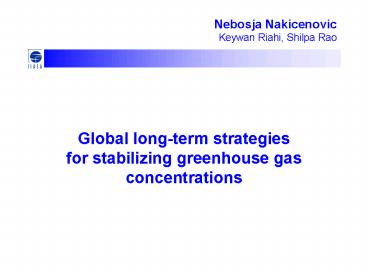Global longterm strategies for stabilizing greenhouse gas concentrations - PowerPoint PPT Presentation
Title:
Global longterm strategies for stabilizing greenhouse gas concentrations
Description:
IIASA's MESSAGE energy model extended to other GHG emitting sectors ... Emphasis on regional cultures, traditions, cooperation and economic development unions ... – PowerPoint PPT presentation
Number of Views:48
Avg rating:3.0/5.0
Title: Global longterm strategies for stabilizing greenhouse gas concentrations
1
Global long-term strategies for stabilizing
greenhouse gas concentrations
- Nebosja NakicenovicKeywan Riahi, Shilpa Rao
2
Approach
- IIASAs MESSAGE energy model extended to other
GHG emitting sectors (agriculture and forestry
including C sinks) - Multi-gas (CO2, CH4, N2O, HFC, CF4, SF6) black
carbon - Bottom-up representation of mitigation
technologies - Endogenized competition of mitigation options
across all sectors - Endogenized energy feedback effects from non-CO2
mitigation (capture of CH4 in coal mines, CH4
from landfills, etc.) - Global, 11 world regions, up to 2100
- Output Costs, main mitigation measures,
uncertainties
3
The fossil fuel intensive path A2SRES
assumptions
- High population (12 bn)
- Low per-capita income
- Fossil fuel intensive development
- Fragmented world
- Emphasis on regional cultures, traditions,
cooperation and economic development unions - Little technology transfer to developing
countries - Large regional disparities
- Ratio of North-South income gap 41 in PPP (as
today) - Very little further convergence
4
The sustainable development path B1SRES
assumptions
- Rapid global economic development, high
per-capita income - Fast economic "catch-up" of developing countries
North-South income gap reduced to less than
21 (PPP) - Rapid structural change of the global economy
- Dematerialization" of the economies
- Reduced energy intensity
- Changed life styles
- Invoked by increased environmental awareness
5
Global GHG emission paths SRES A2 and B1no
climate measures scenarios Gt C/yr
A2 Fossil fuel intensive
B1 Sustainabledevelopment
6
The sustainable development path B1Assumed
non-climate policies (according to SRES)
- Globalization with enhanced multi-lateral
cooperation - Technology transfer with fast introduction of
advanced technologies also in developing
countries - Successful large-scale RD programs
- Targeted population policies to reduce fertility
rates in developing countries - World population 6 billion
- Other sustainable development policies
- Aggressive air pollution control
- Stringent efficiency standards
7
Illustrative stabilization analysisfor the A2
and B1 paths
- Illustrative GHG stabilization target
- 4.5 W/m2 radiative forcing (2.3 degrees C)
increase in 2100 compared to pre-industrial
levels - To be achieved through control of all 6 Kyoto
gases - Provisional analysis uses 100 years GWPs
8
Global GHG emission pathsA2 and B1 stabilization
cases Gt C/yr
A2 Fossil fuel intensive
B1 Sustainabledevelopment
9
Main mitigation measuresCumulative carbon
removal, 2000-2100 Gt C
800
10
Co-benefits of GHG stabilizationon emissions of
black carbon and organic carbon, A2 scenario Mt
Black carbon
Organic carbon
Emission reductions from stabilization in
11
Conclusions
- Sustainable development paths achieve a
significant share of stabilization effort as a
co-benefit - In fossil-intensive paths stabilization efforts
are very costly - Non-CO2 mitigation options reduce stabilization
costs - Mitigation of non-CO2 gases make an important
contribution in the near-term, but CO2
mitigation remains essential in the long-term - GHG stabilization paths lead to a significant
reduction of black and organic carbon as a
co-benefit































